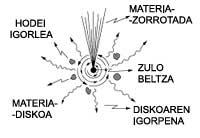Oven 3C273 (and II)
Reading what was said in the previous issue, we already know the main peculiarities of the energy emission of the tanks. Its intensity is enormous on the one hand, originating in a relatively small region and, on the other, the particularities are the density that reaches the material that accumulates in that area. But this description is even more surprising if we add some of the data offered by the growth of Quasi Network 3C273 activity between February and May 1988.
For example, the two emission maximums measured in the field of infrared waves doubled the emission level in a calm state. In addition, the magnitude of growth was such that in some phases an energy per second was produced equivalent to 10 million Sun lit. In the field of visible light, so much range was measured, but in this case the reduction after a maximum, that is, the reduction of energy per second, would correspond to 10 million solar blackouts.

As we said in the previous issue, quasars are hyperactive galaxies. The luminosity of the galaxy's core overshadows the environment and is difficult to see. However, more detailed observations made at the time when it was proposed that they could be extragalactic objects, revealed this latter structure. In the case of the network of quasars 3C273, a jet of matter was found that joined the two radio-emission centers.
Therefore, with special interferometry techniques, in June 1988 it was observed that a further jet of the source was forming. Thanks to repeated efforts nine months later, in addition to confirming this formation, the apparent speed of distance from matter could be calculated. This data estimated that the output of matter and the increase in electromagnetic emission occurred at the same time, demonstrating the relationship between both phenomena.
The strong increase in the aforementioned issue is the first offered by the cuasare studies. It will take many years of observation to decide whether these high activity deadlines are as rare as they seem and even more to find an adequate explanation. However, the first work is to find an energy source that meets the particularities we have defined at the beginning.
For most scientists, energy generation must be the result of a gravitational interaction. The study of spraying has taught us that a field of gravity can bring much more energy than nuclear interaction itself. According to the most accepted theory, pulse networks are formed with supernovae. The latter occur when a red supergiant star reaches the last steps of its life, suffers a gravitational contraction and falls toward the center. Much of the matter is removed again by a bounce effect, but in the area remains a high density neutron star.
This neutron star takes advantage of its powerful gravity field to attract the matter around it. When matter falls, it releases gravitational energy and then, in the star, undergoes nuclear processes that generate impulses. It is estimated that the energy released by nuclear reactions is only a hundred of the energy due to gravity. Therefore, it is considered that also in the case of quasars, the force of gravity must be the work done. In this case, since the energy to be justified is so great, the only option that can be proposed as a generator is that it is a large black hole.
The gravity field of these objects does not allow the leakage of light. Therefore, they are not visible and can only be found through the effects they produce in their environment.
Since nothing can reach us through the black hole, the emission that reaches us must be the one generated around it. The main source would be the disc that forms the matter that swallows the black hole when falling. In this whirlwind the speed of matter would be close to that of light. Therefore, in addition to overheating gas, plasma would become a conductor. The energy of the magnetic fields, due to the electric currents that would be generated as a consequence, would become a new contribution of heat. All this heat energy would be responsible for radiation.

Since the emission power in the case of the 3C273 kiln object of study is about 10 40 watts, the absorption rate of matter can be calculated. For example, if we consider that the performance of the process of transformation of gravity energy into radiation is 10%, the black hole should ingest 10 24 kg/s, that is, some Solar every year. The image depicts the example of the possible structure of a quasare. In the center we have a black hole and around a disc of matter. From the disc, the radiation produced by both the jet of matter and the heat would be extracted. In addition, the latter would excite the clouds of matter in the area and turn them into stations.
It is believed that the half-life of the blocks is not very long. It may not exceed 1,000 million years. Therefore, some believe that it would be a quasare and today most of them would be totally slowed down. If things have been so, the radiation from the black hole would affect the formation of the galaxy. In turn, the formation of stars would retain the gas clouds that feed the black hole, but we can still say little about this problem.
Another hypothesis that lately is quite accepted is that there could be a black hole in the core of the French Way. However, according to the data we currently have, this black hole would be relatively small. Therefore, the French Way has probably not been a spoon, although at a much lower level a similar phase of activity has developed.
SUN: January 20, 1 h 23 min (UT) The Sun enters Aquarius.
PLANETS
|
Buletina
Bidali zure helbide elektronikoa eta jaso asteroko buletina zure sarrera-ontzian











